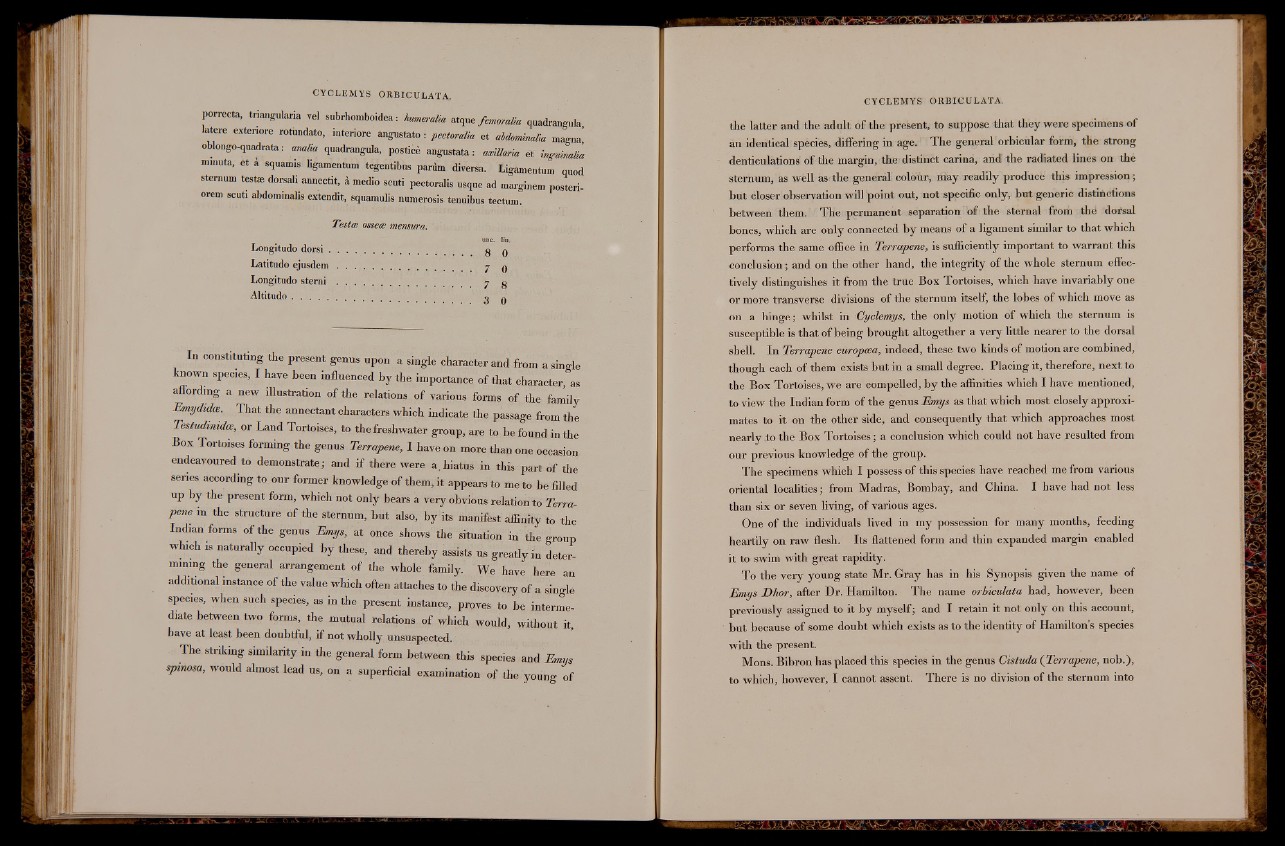
porrecta, triangularía vel subrhomboidea: humeralia atque femoralia quadrangula,
atore extenore rotündato, interiore angustato: pectoralia et abdomimlia magna,’
oblongo-quadrata: analta quadrangula, posticé angustata: amilana ét inguinalia
minuta, et á squamis ligamentum tegentibus pardm diversa. Ligamentum quod
sternum test* dorsali annectit, á medio scuti pectoralis usque ad marginem posteriorem
scuti abdominalis extendit, squamulis numerosis tenuibus tectum.
Testee osseee mensura
Longitudo d o r s i.........................
Latitudo e ju sd em .................................
Longitudo s t e r n i ................................
Altitudo......................
unc. lin.
. 8 0
. 7 0
8
0
In constituting the present genus upon a single character and from a single
known species, I have been influenced by the importance of that character, as
affording a new illustration of the relations of various forms of the family
Emydidce. That the annectant characters which indicate the passage from the
Testudmidce, or Land Tortoises, to the freshwater group, are to be found in the
Box Tortoises forming the genus Terrapene, I have on more than one occasion
endeavoured to demonstrate; and if there were a,hiatus in this part of the
series according to our former knowledge of them, it appears to me to be filled
up by the present form, which not only bears a very obvious relation to Terrapene
in the structure of the sternum, but also, by its manifest affinity to the
Indian forms of the genus Emys, at once shows the situation in the group
which is naturally occupied by these, and thereby assists us greatly in determining
the general arrangement of the whole family. We have here an
additional instance of the value which often attaches to the discovery of a single
species, when such species, as in the present instance, proves to be intermediate
between two forms, the mutual relations of which would, without it,
have at least been doubtful, if not wholly unsuspected.
The striking similarity in the general form between this species and Emys
spinosa, would almost lead us, on a superficial examination of the young of
the latter and the adult of the present, to suppose that they were specimens of
an id enticab species, differing in age. ' The general orbicular form, the strong
denticulátionS of the margin, the distinct carina, and'the radiated lines on the
sternum, as well as the general colour, may readily producé this impression;
but closer observation will point out, not specific only, but generic distinctions
between them. The permanent separation of the sternal from the dorsal
bones, which are only connected by means of a ligament similar to that which
performs the same office in Terrapene, is sufficiently important to warrant this
conclusion; and on the other hand, the integrity of the whole sternum effectively
distinguishes it from the true Box Tortoises, which have invariably one
or more transverse divisions of the sternum itself, the lobes of which move as
on a hinge; whilst in Cyclemys, the only motion of which the sternum is
susceptible is that of being brought altogether a very little nearer to the dorsal
shell. In Terrapene europcea, indeed, these two kinds of motion are combined,
though each of them exists but in a small degree. Placing it, therefore, next to
the Box Tortoises, we are compelled, by the affinities which I have mentioned,
to view the Indian form of the genus Emys as that which most closely approximates
to it on the other side, and consequently that which approaches most
nearly J;o the Box Tortoises; a conclusion which could not have resulted from
our previous knowledge of the group.
The specimens which I possess of this species have reached me from various
oriental localities; from Madras, Bombay, and China. I have had not less
than six or seven living, of various ages.
One of the individuals lived in my possession for many months, feeding
heartily on raw flesh. Its flattened form and thin expanded margin enabled
it to swim with great rapidity.
To the very young state Mr. Gray has in his Synopsis given the name of
Emys Dhor, after Dr. Hamilton. The name orbiculata had, however, been
previously assigned to it by myself; and I retain it not only on this account,
but because of some doubt which exists as to the identity of Hamilton’s species
with the present.
Mons. Bibron has placed this species in the genus Cistuda ( Terrapene, nob.),
to which, however, I cannot assent. There is no division of the sternum into